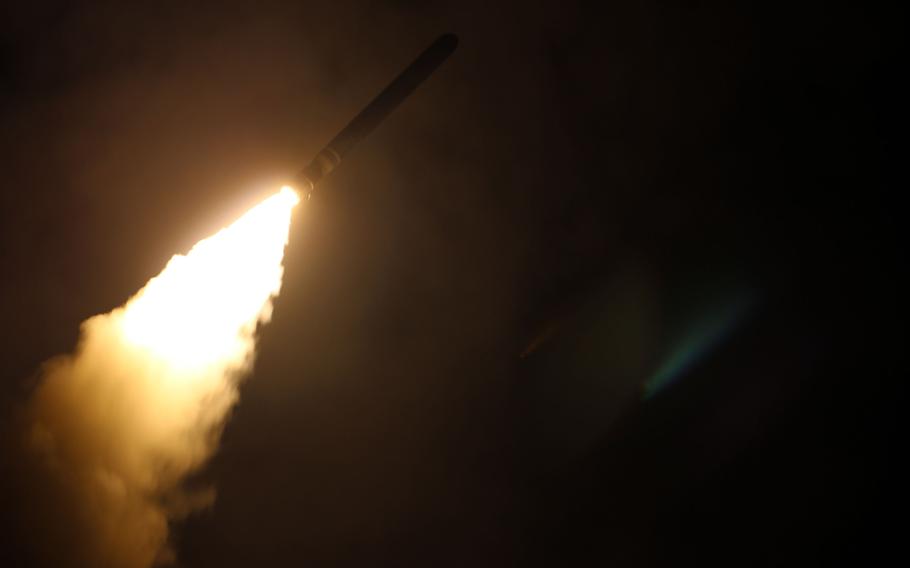
The guided-missile destroyer USS Laboon fires a Tomahawk land-attack missile at a target in Syria, April 14, 2018. (Kallysta Castillo/U.S. Navy)
TOKYO — Japan wants to accelerate a plan to purchase Tomahawk missiles from the United States to the coming fiscal year rather than wait another three years, Defense Minister Yasukazu Hamada said Tuesday.
Hamada declined to say how many Tomahawk cruise missiles the government plans to buy and said doing so would disclose Japan’s defense capabilities. But an earlier report Tuesday by the Kyodo News agency, citing an unnamed government source, said the government wants as many as 500 of the missiles.
Japan has moved to strengthen its military in recent years amid a rapid Chinese military buildup and North Korean missile tests.
The country could buy a package of Tomahawks in fiscal 2023, which starts in April, instead of acquiring them over the next several years as initially planned, Hamada said at a news conference.
The missiles would be the same type used by the U.S. Navy and can be launched from Aegis destroyers of the Japanese Maritime Self-Defense Force, the Kyodo source said.
A Tomahawk can strike targets at a range of 1,000 miles, according to its maker, Raytheon Technologies.
Prime Minister Fumio Kishida's administration is also considering talks with the U.S. over deploying the missiles sooner than fiscal 2026, the original schedule, the source told Kyodo.
Tokyo approved a national security strategy in December that includes acquiring “counterstrike” capabilities to attack enemy bases with missiles.
A defense budget for the coming fiscal year totaling $51.4 billion, the nation’s largest ever, was approved Dec. 23 by Japan’s Cabinet. It includes $1.59 billion to acquire Tomahawks and $963 million to develop and manufacture improved surface-to-ship guided missiles.
Beijing has more than 1,900 ballistic missiles that can reach Japan, according to a 2022 Pentagon report on China’s military capabilities.
In a Jan. 13 joint statement following talks in Washington, Kishida and President Joe Biden said they had instructed their ministers to reinforce cooperation on the development and effective employment of Japan’s counterstrike capability.
Japan’s government may be attempting to “strike while the iron is hot,” Ralph Cossa, president emeritus of the Pacific Forum think tank in Hawaii, said in an email Friday.
“There has been surprisingly little resistance or opposition to Japan acquiring or developing what others would categorize as offensive missile capabilities, despite their counterstrike connotation,” he said.
The move is acceptable, if not preferable, to Washington as it looks for allies to step up as part of integrated deterrence, Cossa added.